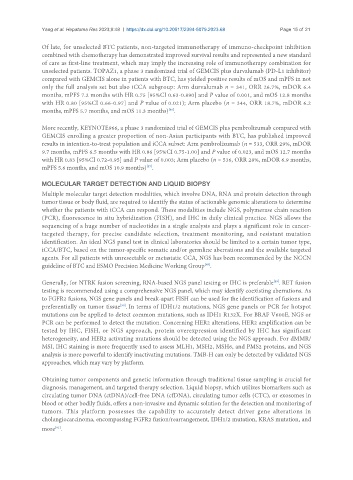Page 165 - Read Online
P. 165
Yang et al. Hepatoma Res 2023;9:48 https://dx.doi.org/10.20517/2394-5079.2023.68 Page 15 of 21
Of late, for unselected BTC patients, non-targeted immunotherapy of immuno-checkpoint inhibition
combined with chemotherapy has demonstrated improved survival results and represented a new standard
of care as first-line treatment, which may imply the increasing role of immunotherapy combination for
unselected patients. TOPAZ1, a phase 3 randomized trial of GEMCIS plus durvalumab (PD-L1 inhibitor)
compared with GEMCIS alone in patients with BTC, has yielded positive results of mOS and mPFS in not
only the full analysis set but also iCCA subgroup: Arm durvalumab n = 341, ORR 26.7%, mDOR 6.4
months, mPFS 7.2 months with HR 0.75 [95%CI 0.63-0.890] and P value of 0.001, and mOS 12.8 months
with HR 0.80 [95%CI 0.66-0.97] and P value of 0.021); Arm placebo (n = 344, ORR 18.7%, mDOR 6.2
months, mPFS 5.7 months, and mOS 11.3 months) .
[86]
More recently, KEYNOTE966, a phase 3 randomized trial of GEMCIS plus pembrolizumab compared with
GEMCIS enrolling a greater proportion of non-Asian participants with BTC, has published improved
results in intention-to-treat population and iCCA subset: Arm pembrolizumab (n = 533, ORR 29%, mDOR
9.7 months, mPFS 6.5 months with HR 0.86 [95%CI 0.75-1.00] and P value of 0.023, and mOS 12.7 months
with HR 0.83 [95%CI 0.72-0.95] and P value of 0.003; Arm placebo (n = 536, ORR 28%, mDOR 6.9 months,
[87]
mPFS 5.6 months, and mOS 10.9 months) .
MOLECULAR TARGET DETECTION AND LIQUID BIOPSY
Multiple molecular target detection modalities, which involve DNA, RNA and protein detection through
tumor tissue or body fluid, are required to identify the status of actionable genomic alterations to determine
whether the patients with iCCA can respond. These modalities include NGS, polymerase chain reaction
(PCR), fluorescence in situ hybridization (FISH), and IHC in daily clinical practice. NGS allows the
sequencing of a huge number of nucleotides in a single analysis and plays a significant role in cancer-
targeted therapy, for precise candidate selection, treatment monitoring, and resistant mutation
identification. An ideal NGS panel test in clinical laboratories should be limited to a certain tumor type,
iCCA/BTC, based on the tumor-specific somatic and/or germline aberrations and the available targeted
agents. For all patients with unresectable or metastatic CCA, NGS has been recommended by the NCCN
[88]
guideline of BTC and ESMO Precision Medicine Working Group .
Generally, for NTRK fusion screening, RNA-based NGS panel testing or IHC is preferable . RET fusion
[89]
testing is recommended using a comprehensive NGS panel, which may identify coexisting aberrations. As
to FGFR2 fusions, NGS gene panels and break-apart FISH can be used for the identification of fusions and
preferentially on tumor tissue . In terms of IDH1/2 mutations, NGS gene panels or PCR for hotspot
[90]
mutations can be applied to detect common mutations, such as IDH1 R132X. For BRAF V600E, NGS or
PCR can be performed to detect the mutation. Concerning HER2 alterations, HER2 amplification can be
tested by IHC, FISH, or NGS approach, protein overexpression identified by IHC has significant
heterogeneity, and HER2 activating mutations should be detected using the NGS approach. For dMMR/
MSI, IHC staining is more frequently used to assess MLH1, MSH2, MSH6, and PMS2 proteins, and NGS
analysis is more powerful to identify inactivating mutations. TMB-H can only be detected by validated NGS
approaches, which may vary by platform.
Obtaining tumor components and genetic information through traditional tissue sampling is crucial for
diagnosis, management, and targeted therapy selection. Liquid biopsy, which utilizes biomarkers such as
circulating tumor DNA (ctDNA)/cell-free DNA (cfDNA), circulating tumor cells (CTC), or exosomes in
blood or other bodily fluids, offers a non-invasive and dynamic solution for the detection and monitoring of
tumors. This platform possesses the capability to accurately detect driver gene alterations in
cholangiocarcinoma, encompassing FGFR2 fusion/rearrangement, IDH1/2 mutation, KRAS mutation, and
more .
[91]

